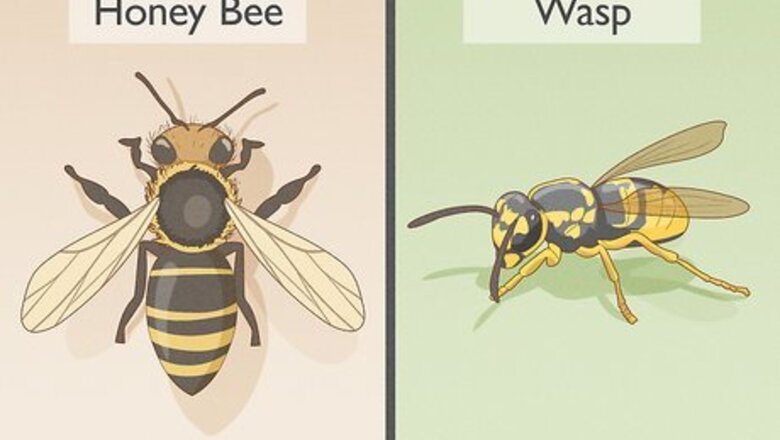
views
Identifying the Species
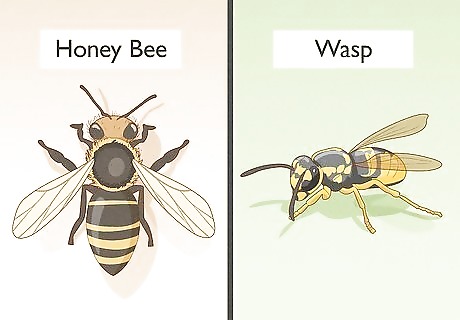
Make sure you’re dealing with bees. Whenever you spot what you think is a bee, take a good look at the insect before you attempt to do anything else. Confirm that it is indeed a bee and not a wasp or hornet. Tell the difference by: Hair: Bees appear furry all over. Wasps and hornets may have a small amount of hair on their bodies, but you’d need to inspect them very closely to see it. Food sources: Bees nourish themselves from flowers’ nectar. Wasps and hornets prey on other insects and/or scavenge food waste. Thickness: Bees tend to be pretty plump in the middle, while wasps and hornets have thinner waists and more elongated bodies.
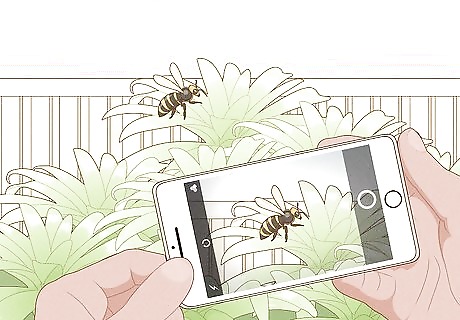
Take a photo to determine what type of bee it is. Expect different types of bees to require different approaches when it comes to getting rid of them. Take a picture of them to show a professional exterminator or beekeeper, or compare it with online resources like https://friendsoftheearth.uk/nature/bee-identification-guide. If you're in the United States, you'll most likely be dealing with honeybees, bumblebees, carpenter bees, or possibly Africanized honey bees.
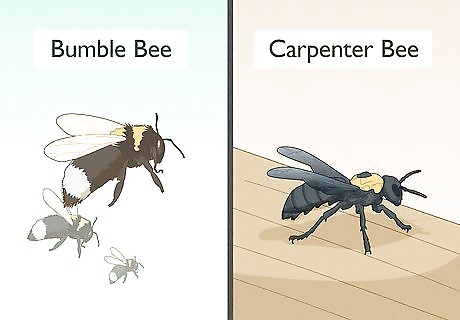
Distinguish between bumblebees and carpenter bees. Expect these two to appear fairly similar at first glance. If you’re comparing photos online and believe that you have one or the other, do a little more digging to be sure. Tell the two apart by: Visual clues: Carpenter bees feature a black dot on the top of their thorax (the part where the wings and legs grow from). They also have less hair than a bumblebee. Sociability: Carpenter bees are solitary, while bumblebees tend to swarm.
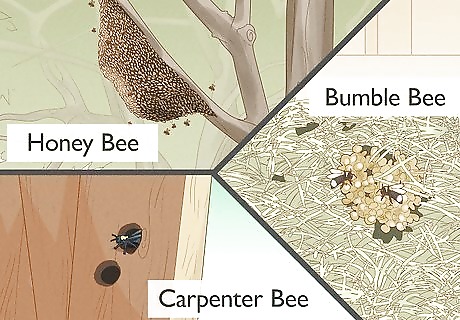
Use their nest to identify them if needed. If you’re unable to take a photo (or if your photos don’t come out that great), don’t worry. Look for their nest. Use that to help narrow down the species. Honeybees’ nests are often found within hollow spaces, such as tree trunks, logs, and fence posts. They usually don’t use home structures to build their nests but are sometimes found in roofs, attics, and wall cavities if there is access from the outside. Bumblebees typically nest in or near the soil, such as in deserted rodent nests, compost piles, or underneath raised outdoor structures like sheds or porches. Carpenter bees usually burrow into wood to build their nests. Look for bee activity around coin-sized holes in things like eaves, porches, and trimming.
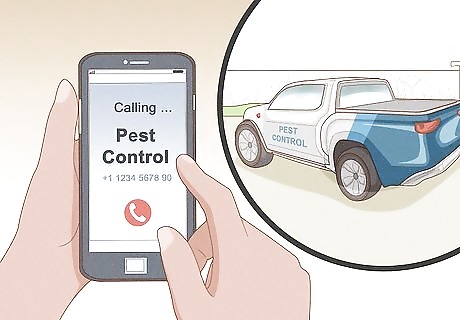
Don't worry if you can't identify them. If you can't figure out what type of bee it is, don't beat yourself up about it. Knowing what type it is will help you anticipate how much work will be needed to get rid of them (and thus cost-compare between companies and budget accordingly), but it's not necessary to start the process. Just contact a pest-control company specializing in bees and arrange for an inspection so they can identify them for you.
Dealing with the Problem
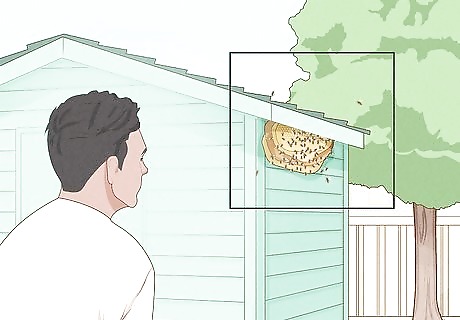
Ask yourself if getting rid of them is necessary. If the bees are only seen outside, consider leaving them alone unless someone is allergic to bees. Remember that they play a major role in the environment by promoting pollination and that honeybees, in particular, have been declining in population over recent years. Also keep in mind that: Although most bees have stingers, they usually only ever use them as a last resort, which means you really have to antagonize them before they sting you. As long as you stay relaxed when they’re around, you should be fine. In fact, some bees (like male carpenter bees) don’t even have stingers. One exception to this rule may be Africanized honey bees, which are much more likely to turn aggressive and stay that way once they’re disturbed.

Take care of bees nesting in your home. If you’re seeing bees inside the house (or if you’ve spotted, say, carpenter bees burrowing into wooden portions of your house), consider this to be a situation where it’s appropriate to get rid of them. Any damage they may cause to the structure will be minimal in the beginning, but expect the risk and extent of damage to increase over time if left untreated. Carpenter bees will continue to expand their nests throughout wooden structures if left alone. Honeybees create honeycombs. These can become quite heavy and possibly damage surrounding areas. The honey may also attract other animals.
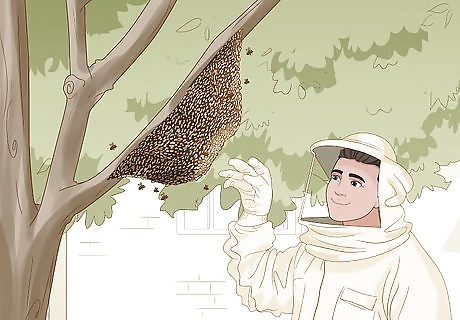
Have professionals take care of them. Killing a single bee is relatively easy, but expect to deal with a whole nest of them to be a much more involved and lengthy process. Keep in mind that if it isn’t done correctly and thoroughly, you’ll most likely end up with a new batch of bees appearing shortly. Also remember: Bees are usually happy to ignore you right up until you start messing with their nest. And though a single bee sting is pretty bearable, you may be faced with dozens, hundreds, or even thousands of the little guys when you attack them at the source. Depending on the type of bee you have, the method for removing them may vary. Professionals may use smoke, pesticides, or other means of extraction for the bees themselves, plus using the second hive to extract honey from the left-behind nest. Removal of the nest itself may also require carpentry work to gain access and repair damage to structures. EXPERT TIP Steve Downs Steve Downs Live Bee Removal Specialist Steve Downs is a Live Honey Bee Removal Specialist, Honey bee Preservationist, and the Owner of Beecasso Live Bee Removal Inc, a licensed bee removal and relocation business based in the Los Angeles, California metro area. Steve has over 20 years of humane bee capturing and bee removal experience for both commercial and residential locations. Working with beekeepers, agriculturalists, and bee hobbyists, Steve sets up bee hives throughout the Los Angeles area and promotes the survival of bees. He has a passion for honeybee preservation and has created his own Beecasso sanctuary where rescued bee hives are relocated and preserved. Steve Downs Steve Downs Live Bee Removal Specialist Our Expert Agrees: Don't use chemicals or soap and water to try to exterminate a bee hive. This will infuriate the bees, and it can be very dangerous. It's also not effective, as the cavity will remain full of wax comb, brood chambers, and honey. The only solution for this situation is to have professionals remove the entire hive to prevent bees from returning.

Contact your local government first. First, determine if the bees’ nest is technically on public property instead of your own. If so, contact your local government and report it so they can deal with it. If not, call them anyway, since they may offer free services to have the nest removed, depending on your area. What free services (if any) are available will depend on your area. They may include extraction of both bees and nests or only the bees themselves. They may or may not include repairs to any structural damage. Free services are more likely to be available if the nest is in a natural structure (like a tree) rather than your home or other manmade structure. However, it’s still worth calling and finding out for sure about their policy regarding manmade structures on your property.
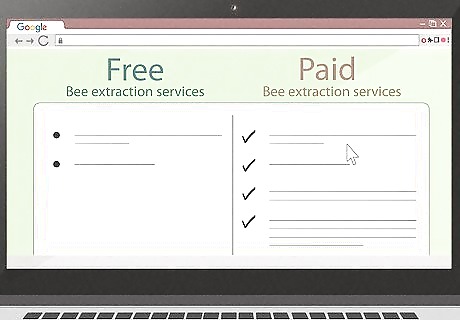
Comparison-shop before going with “free services.” If your local government does provide free bee removal, don’t jump at it immediately. Keep in mind that even though the “free services” offered may technically be free, they won’t necessarily cover all the work that needs to be done. Find out exactly what those services cover and then contact private companies on your own to explore your options. This is of particular importance if the nest is located within your home’s structure. Gaining access to it may involve cutting into the structure to expose the nest. Free services may not include repairs needed afterwards. If repairs aren’t done or are done improperly then new bees might take up residence in the same area. This means it may be cheaper in the long run to hire a private company that will remove the bees, make repairs, and offer a warranty covering future infestations.

Call beekeepers before exterminators to remove honeybees. If you’re sure that you have honey bees, look up local beekeepers in your area. Have the beekeepers remove the honeybees from your property if possible rather than kill them. Remember that healthy honey bees are in decline, which is unfortunate because they play an integral part in pollinating fruit and vegetable crops. If you aren’t able to locate a beekeeper in your area, find a pest control company specializing in bees instead. They may also attempt to remove honeybees before resorting to extermination.

Contact bee specialists rather than general pest control companies. If the bees have nested in your home’s structure (or any other on your property), expect whomever you may hire to possibly have to cut through walls, floors, and ceilings to gain access. Obviously, this means repair work will have to be done afterwards. For this reason, search for pest control companies that specifically specialize in bees. Bee specialists are more likely to take care of repairs themselves, while a more general pest control company will probably only get rid of the bees. This means you will have to either do the repairs yourself or hire a contractor. Bee specialists are also more likely to offer you a warranty in case bees return to the same area, which may save you more money in the long run.
Preventing Bees from Returning
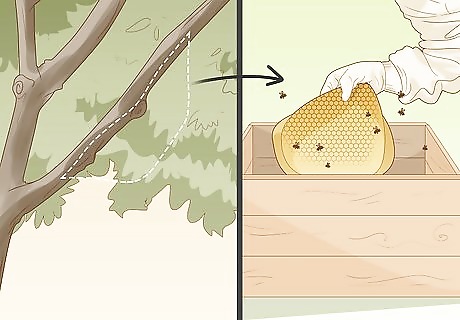
Remove all nests and honeycombs. Make sure that whoever you hire doesn’t kill or remove the bees and leave their nest and honeycomb behind. Expect these to attract new bees. Prevent a new problem by making sure that the old one is taken care of thoroughly.
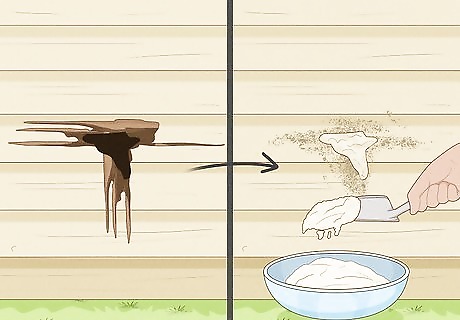
Make all necessary repairs immediately. If the company needed to cut into any part of your home’s structure to reach the nest and didn’t repair the damage themselves, do so immediately. Assume that if one bee colony found this area to be a good place to build a nest, others will, too. Seal off their access to it as soon as possible. Close any other gaps, cracks, or other points of access, too. Remember: if one bee colony set up shop within a structure, others will do the same. Assess the area and identify any points where bees could access it. Seal those points with caulk, insulation foam, or whatever the situation demands.

Clear your property of ideal nesting spots. Limit the number of places where bees can build a nest. Remove any unnecessary junk that has accumulated and now offers bees a perfect spot to build a nest. Depending on which types of bees live in your area, also consider: Blocking access to crawl spaces and underneath raised structures like outdoor sheds, porches, or decks. Filling in old rodent dens and other holes in the ground. Putting compost into a container rather than leaving it as an open pile. Removing hollowed trees and logs.

















Comments
0 comment